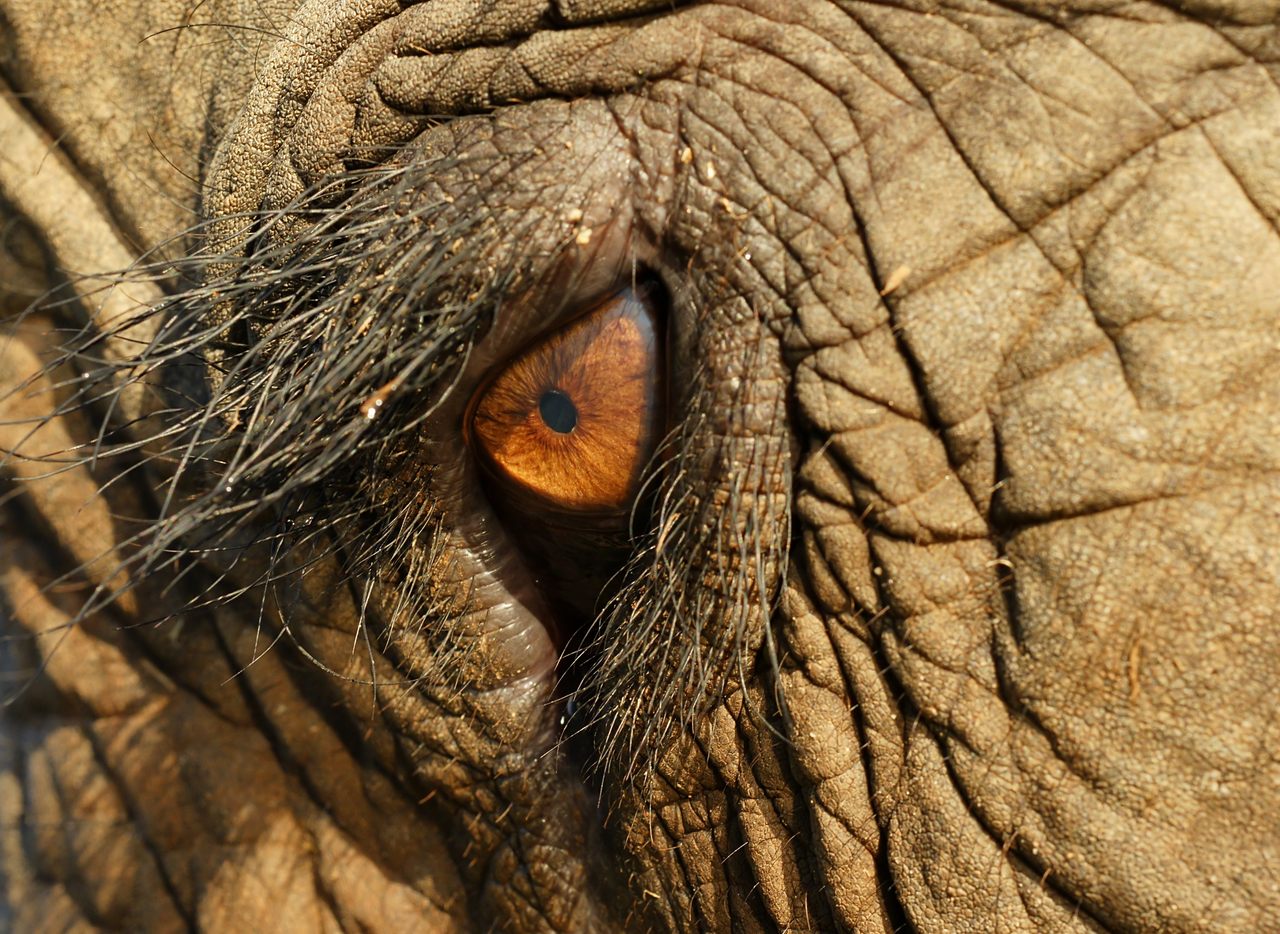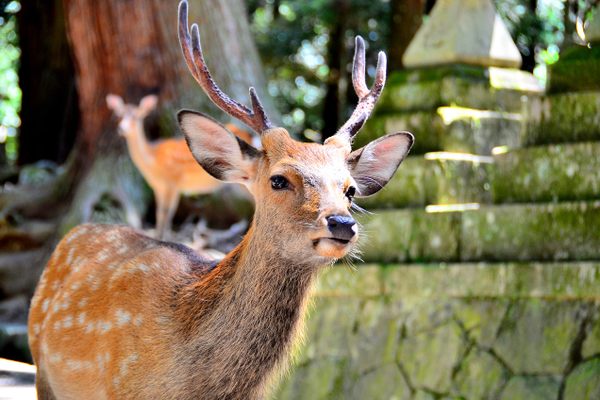To Reduce Conflicts With Humans, Get Inside an Elephant’s Head
Understanding how the giant mammals weigh risk and reward could help prevent clashes with people.
This story was originally published in Undark and appears here as part of the Climate Desk collaboration.
In 2018, news spread around Saroj Duru’s village that four elephants had gathered at a nearby lake. Such creatures didn’t typically visit her region in central India—they were known to stay further north in more forested habitats—and so, out of curiosity, Duru and her neighbors walked down to see them.
The elephants rested in the water as people jostled at the shore, trying to get a closer look. Others climbed trees for a better view. After an hour of savoring the thrill of seeing such large animals, Duru headed back home. She was not sure when she would see them again.
Instead, that same day, a herd rampaged through the village’s farms. “They tore our boundary wall and tore up our banana tree,” Duru said. “They uprooted the gate.”
She was terrified, and, like many of her neighbors, climbed up to her roof for safety. No villagers were killed that night, but the elephants ate budding rice seedlings, damaging the season’s crop.
Around three decades ago, elephants began to push into Chhattisgarh, the state where Duru is from, migrating southwest from their historical habitats. Scientists aren’t sure why they began to move, but some think they were pushed out as mining and other human activities devastated their home forests. India lost 1.6 million acres of forest between 2015 and 2020, second only to Brazil.
Those shifts have generated friction between humans and the pachyderms: Each year, elephants kill around 400 people in India, according to a 2020 study. Around 150 elephants die due to conflict with humans as well, with many more electrocuted by fences or struck by trains.
Now, many people—from farmers to forest service employees to elephant scientists—are working to understand the movements and behaviors of a species that’s been subject to decades of intensive conservation work. As farmers like Duru try to come to terms with their new neighbors, many researchers are developing a nuanced view of elephant life—one which focuses on them less as pests out to eat people’s hard-earned crops, and more as members of complex communities, with distinctive traditions and cultures, undergoing a series of pressures that can have tragic consequences.

In studying human-elephant conflict, researchers have often focused on mapping the animals’ movements and numbers, studying whole populations rather than zooming in on how a single elephant might weigh risk and reward.
“We’ve not really taken behavior as a core or the basis for our decisions,” said Nishant Srinivasaiah, an elephant behavior ecologist based in southern India. While group data is also important, he and his colleagues believe researchers should pay more attention to how individual elephants make decisions, understanding them as highly intelligent animals attempting to navigate a changing environmental and social landscape.
An old debate in Indian conservation circles is whether humans have the right to their lives and livelihood in areas where they come up against wildlife, or whether the state should sometimes evict people to protect the animals. This already contentious argument fractures in places like Chhattisgarh, where the state is grappling with how to protect both communities.
Researchers across Asia, like Srinivasaiah, are trying to bridge this gap by gathering data to help understand the complex internal lives of elephants, and what interventions humans can make to nudge the animals away from conflict. When—and whether—those interventions might make a significant difference is still an open question.
It’s a blazing hot afternoon in December 2022, and Srinivasaiah deftly pilots his rugged Maruti Suzuki Gypsy through the narrow one-lane road of a village near the Cauvery Wildlife Sanctuary in south India. He eventually pulls up to a white concrete house, home to the field office of the Frontier Elephant Program, an interdisciplinary research group.
Srinivasaiah works in the southern state of Karnataka, far from Chhattisgarh. But he and his colleagues want to answer questions that are relevant to people like Duru: How do elephants make decisions about where to forage or migrate? Why has their social behavior changed over time? And how can the animals be nudged away from conflict?
Inside the group’s village office are two cots and a wide table where Srinivasaiah and his colleagues set up their laptops. The heart of the group’s tracking operations hangs on a wall: a large whiteboard that lists the status of the dozens of camera traps that the team has seeded in the deciduous forest near the village.
The devices are installed on trees at about four to five feet off the ground, and take photos when they detect movement. Researchers also follow elephants on foot to photograph them and observe their behavior. These thousands of images create a library of the activities, movement, and habits of hundreds of elephants in and around the 250,000-acre wildlife sanctuary. After spending countless hours sifting through photos, Srinivasaiah and his colleagues can often recognize an individual from the shape of an ear, a chipped tusk, a scar.
The team divides observed behaviors into three categories: affiliative interactions, when elephants bond with each other; agonistic behavior, when they exert dominance; and neutral or self-directed behavior, such as eating, flapping their ears, or dusting themselves. They track how often elephants engage in these behaviors, and the precise places they do them.
Using this information, the team can tease out subtleties of elephant interactions. For instance, researchers have long understood that adolescent male Asian elephants disperse from their natal herds, and generally live a relatively solitary lifestyle until they enter musth, the period during which they seek to mate. But Srinivasaiah has found that in areas populated by humans, bulls are starting to form long-lasting cohesive groups even when they are not raiding crops. In a 2019 study, Srinivasaiah and several colleagues speculated that the male elephants may choose to band together to survive threats from human development.
His team has also observed that, while elephants communicate audibly in forested areas, when they are near humans they switch to infrasound communication at a frequency below the range of human hearing. “Elephants are exhibiting something that is called third-order behavior, which is ‘I know that you know that I am here’,” he said. Only a few other species, such as dolphins and chimpanzees, exhibit this kind of plasticity, Srinivasaiah said.

Understanding these types of behaviors, he and other elephant researchers say, represents a shift in the field of human-elephant conflict. Rather than seeing the species as a monolith that responds to stimuli without variation, researchers are getting a better view of their complexity, which could in turn inform how the government designs interventions to reduce conflicts.
Srinivasaiah said that a newly popular intervention in India, born from the careful observation of elephant decision-making, might help to reduce conflicts. Elephants can dismantle regular electrified fences within months of encountering them for the first time, often just by pushing them down with large branches. In response to this behavior, a new kind of fence consists of lightly electrified wires, suspended several feet above the ground. The free-hanging wires sway in the breeze so that the elephants find it difficult to tear them down, even as they get buzzed by them.
Srinivasaiah’s hope is that the elephants will conclude the reward of passing a fence isn’t worth the pain and hassle. A prototype fence that the Frontier Elephant Program installed around a mango orchard in their study area has successfully kept elephants away for three years now. Elephants had previously raided the same orchard 38 times in the span of two years.
Increased development—such as urbanization and mining projects—means that more undisturbed elephant habitat will be converted to human use, leading to more human-elephant interactions, Srinivasaiah said. “Knowing elephants and how they are deciding their next move, that is critical for us,” he added.
In the 1980s, when researchers began to study how Asian elephants come into conflict with humans, the elephants themselves were on the move, part of a series of massive changes that have reshaped elephant—and human—life in India.
Entire elephant clans, led by their matriarchs, decided to move away from their original habitats in forested areas in southern and eastern India. One of the first recorded elephant migrations in India was in the early 1980s, when around 50 elephants moved from Tamil Nadu, India’s southernmost state, across state boundaries to Andhra Pradesh.
Raman Sukumar, a pioneering elephant ecologist in India, had been observing that clan in a particular valley. “In 1983, my area’s elephants were suddenly not there,” he said.
Researchers outside of India have also noticed the strain that environmental pressures and poaching seem to put on elephant communities, leading to upheaval. Clans have moved to new places. Elephant behavior has shifted. In Kruger National Park in South Africa, researchers found that young elephants who had survived a mass culling suffered psychological distress similar to PTSD.
“Elephant society in Africa has been decimated by mass deaths and social breakdown from poaching, culls, and habitat loss,” a group of researchers wrote in Nature in 2005.
Similar shifts, happening over decades, are felt keenly in places like Gudrudih, where Duru and her neighbors have to adjust to new elephants.
In the nearby village of Borid, which sits adjacent to the Barnawapara Wildlife Sanctuary, elephants are a constant threat. People have changed their cultivation patterns after learning that elephants prefer some crops, such as rice, to others.
Locals feel like they have limited recourse. Under India’s Wild Life (Protection) Act of 1972, killing an elephant is punishable by three to seven years in prison which makes people wary of more violent action against the large mammals.

“We have no traditional way to chase elephants,” said Dashrath Khairwar, a farmer. Like others in the area, he believes that the government has conspired to relocate the elephants here from another forest.
Residents say the state has done little to help them adjust to their new neighbors. Though the state’s Forest Department has publicized a helpline for elephant sightings, locals say that they do not always get assistance when they call. Instead, they have to settle for compensation for crop losses of 500 to 700 rupees ($6 to $9) per acre. Saroj Duru said she received the equivalent of about $120 for three years of crop damage, and nothing at all for rebuilding her home compound.
Government officials told Undark in an interview that their interventions have been effective in cutting down on crop damage and loss of life. In 2019, state officials recorded damage to nearly 4,000 acres of agricultural land in Mahasamund district. Between January and July 2022, the state recorded only 2.2 acres of damage in the same district. However, Saroj Duru says that in 2022, around 10 to 15 people in just her village reported crop damage.
Pankaj Rajput, the highest-ranking forest official of the district, attributes the reduction in casualties and damage to a central government initiative called the Gaj Yatra, which roughly translates to Elephant Journey. Based on research by the Wildlife Trust of India, Gaj Yatra—which launched in 2017—aims to sensitize people to protect elephants. The Forest Department alerts citizens about elephant movements through WhatsApp and educates people about how to engage with them.
In the 14 months since they implemented Gaj Yatra in his district, Rajput said in December, “we have had zero human deaths, zero human injuries and zero elephant deaths or injuries.”
In January 2022, however, a young elephant was killed in an illegal electrified fence in Mahasamund district, said resident Hemlata Rajput. Three people who set up the fence, she said, have been charged.
But, villagers said, the elephants are still there—and still feel like a constant threat.

In Borid, as in Gudrudih village, people are grappling with their own questions. Where did the animals come from? Are they going to be here forever? And can the villagers ever coexist with the elephants?
Like Srinivasaiah, other researchers are now working to understand individual elephant behavior in order to address those questions. “There is a growing focus on how ecological and behavioral data can be applied directly to human-elephant conflict mitigation,” said Joshua Plotnik, a comparative psychologist at Hunter College who studies elephants in Thailand.
In a 2022 paper, Plotnik and his colleagues reported on how elephants’ decisions to raid crop fields or interact with humans can be influenced by sensory information from scents or sounds. Mitigation strategies might target these senses, such as by burning chilies to prevent elephants from smelling crops; or by playing audio of matriarchal elephant groups—which male elephants tend to avoid when not sexually active—to deter the bulls from venturing to human settlements.
Such strategies tap into what researchers already know or are beginning to learn about disgust or disease-avoidance in elephants, as Plotnik and colleagues wrote about in a 2023 paper for the Journal of Animal Ecology.
But while scientists hope such research could lead to engineering solutions that minimize conflict, the fruits of their labor have not yet quite come to pass. Most interventions still rely on a one-size-fits-all approach rather than the more tailored technique that researchers such as Plotnik and Srinivasaiah envision.
If and when such interventions are developed, it’s also not certain that elephants won’t outsmart them. “It becomes sort of like an arms race,” as each new crop raiding solution is bested by the animals, said T.N.C. Vidya, a researcher of elephant socioecology and behavior at the Jawaharlal Nehru Center for Advanced Scientific Research.
“When you have things like conflict, usually the problem is that people are looking at the conflict from the human point of view,” said Vidya. It’s important, she added, to examine their behavior independent of humans and outside of conflict, “because that probably influences what they’re doing when they’re coming into conflict.”
Frontier elephants exist at the boundary of human-use landscapes, which makes clashes inevitable. And as those boundaries expand, such clashes are likely to increase in frequency.
For now, many people in India feel stuck—uncertain of how to respond to the elephants, reliant on government aid that they said is often not forthcoming, and forced to invest in costly interventions that may have limited effect.
Many of the measures that they can take to protect themselves imply huge long-term investments. In Nandbaru village, close to the Barnawapara Wildlife Sanctuary, a resident said the village government spent 250,000 rupees, or $3,000, to set up an electrified fence around their village over three years. At one point, an elephant got trapped inside that fence, leaving the entire village stuck inside the perimeter until the Forest Department was able to extricate it.
If elephants decide to move on, this will have been only a temporary deterrent. After a research team in Chhattisgarh radio collared elephants in the northern part of the state, they found that some of them have since moved further, leaving behind only the lingering memories of fear and uncertainty.
Khairwar, the farmer from Borid, lamented the indifference of the Forest Department. When people call helpline numbers for help to chase elephants away from fields, officials do not often come. “They come only after an incident happens,” he said. Resigned to having to deal with elephants for years to come, he added, “They are here to stay.”
Reporting for this story was supported in part by a grant from the Keystone Foundation, an environmental and conservation advocacy organization based in Tamil Nadu, India, that focuses on sustainable development and indigenous rights.






















Follow us on Twitter to get the latest on the world's hidden wonders.
Like us on Facebook to get the latest on the world's hidden wonders.
Follow us on Twitter Like us on Facebook